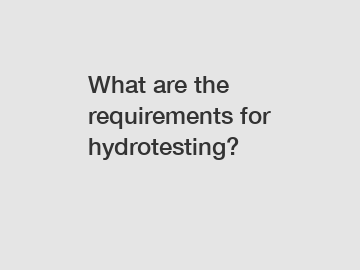Jan. 22, 2024
Energy
TimEast contains other products and information you need, so please check it out.
What are the requirements for hydrotesting? This is a question often asked by those involved in various industries such as oil and gas, construction, and manufacturing. In this article, we will delve into the details of hydrotesting, exploring its requirements, the rationale behind them, and the significance and impact of adhering to these requirements.
Hydrotesting is a crucial process used to test the integrity and strength of pressure vessels, pipelines, and other equipment that is designed to contain fluids or gases under high pressure. It involves subjecting the equipment to elevated pressures using water or other suitable testing mediums. The purpose of this test is to identify any potential leaks, weaknesses, or defects that could compromise the safety and reliability of the equipment.

Now, let's explore the requirements for hydrotesting. The first and foremost requirement is to ensure compliance with applicable industry standards and regulations. Different industries may have specific guidelines and requirements to follow during hydrotesting. For example, the American Society of Mechanical Engineers (ASME) Boiler and Pressure Vessel Code provides extensive guidelines and acceptance criteria for hydrotesting. Similarly, the International Organization for Standardization (ISO) has standards such as ISO 1167 that outline hydrostatic testing methods for plastic pipes.
Additionally, it is essential to carefully select the testing medium, typically water, and ensure its quality and cleanliness. The water used for hydrotesting should be free from impurities, chemicals, or substances that could corrode or damage the equipment being tested. This requirement helps prevent any adverse effects on the equipment and ensures accurate test results.
Suggested reading:Furthermore, the equipment to be tested must be carefully prepared before conducting hydrotesting. This involves cleaning, inspecting, and performing any necessary repairs or modifications to eliminate existing defects or damages. The proper preparation of equipment is crucial for reliable and accurate test results and ensures the safety of personnel involved in the testing process.
The rationale behind these requirements is simple yet crucial. By adhering to industry standards and regulations, using clean and suitable testing mediums, and properly preparing the equipment, hydrotesting can accurately and effectively identify any potential issues. This helps prevent accidents, leaks, or failures that could have catastrophic consequences, especially in industries such as oil and gas where the failure of equipment under high pressure could lead to severe environmental damage, injury, or even loss of life.
The impact of meeting hydrotesting requirements is significant. It ensures the safety and reliability of pressure vessels, pipelines, and other critical equipment. By identifying and rectifying any defects or weaknesses in advance, the chances of unexpected failures and equipment breakdowns are significantly reduced. This ultimately leads to increased operational efficiency, reduced maintenance costs, and enhanced overall safety for both personnel and the environment.
In conclusion, the requirements for hydrotesting encompass compliance with industry standards, the use of suitable testing mediums, and thorough equipment preparation. These requirements are crucial for identifying potential issues, ensuring safety, and maintaining the integrity of pressure vessels and pipelines. Adhering to these requirements has a significant positive impact on operational efficiency, maintenance costs, and overall safety.
Are you interested in learning more about Flange Management Process? Contact us today to secure an expert consultation!
Suggested reading:Previous: Which single phase to three phase inverter offers the best performance and reliability?
Next: The Ultimate Guide: Safe Low Voltage Lithium Batteries
Related Articles
If you are interested in sending in a Guest Blogger Submission,welcome to write for us!
All Comments ( 0 )